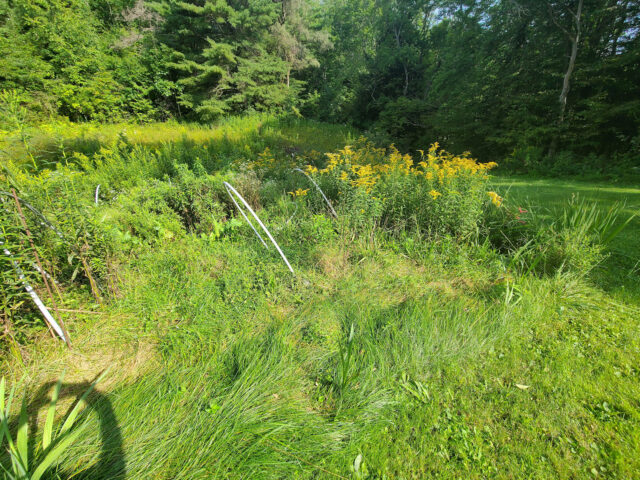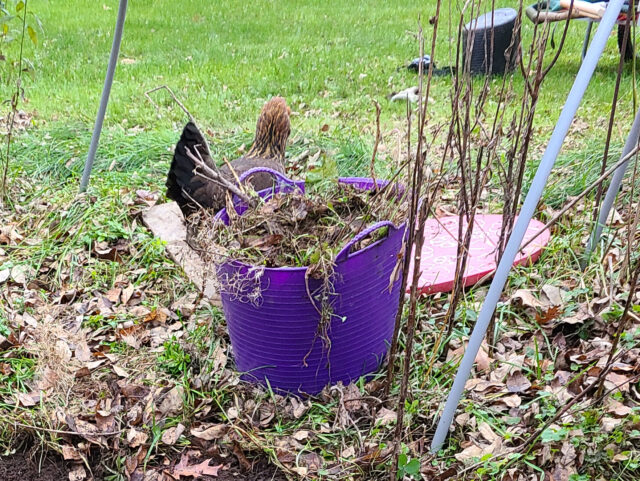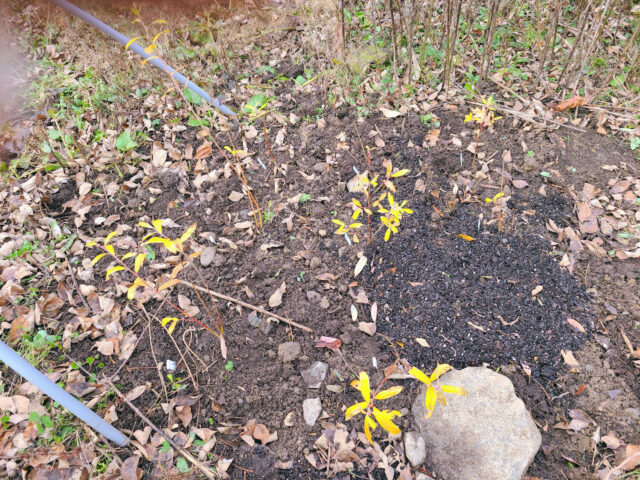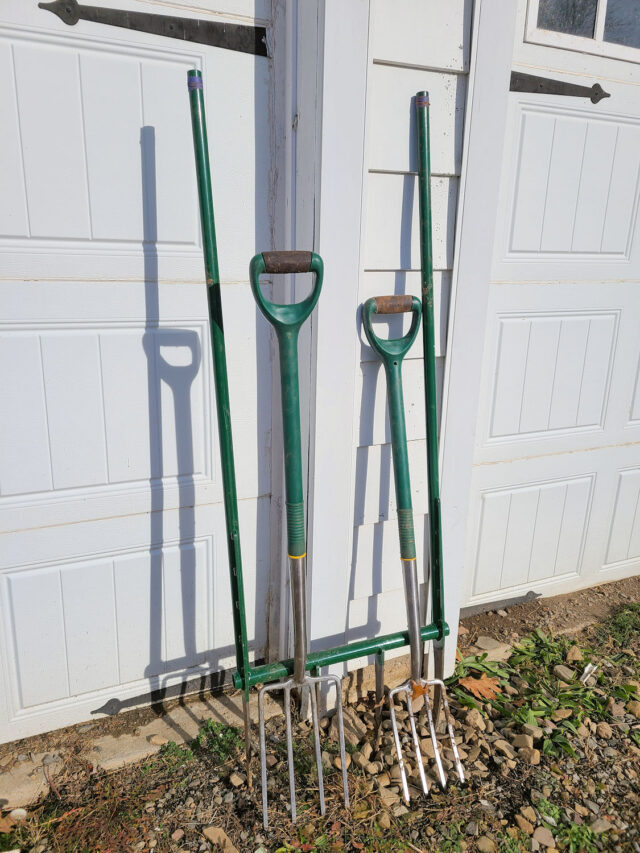I decided on a broadfork in a roundabout way. I was rooting pink pussy willow cuttings and wanted to give them a cushy home for a few years before planting them in their wilder, permantent location. I had surplus colchicum corms that I knew I could find a good home for–but maybe not right away.
What I needed was a nursery bed.

What I had was an overgrown section of an abandoned vegetable garden. Oh, those weeds! Goldenrod and dock, some taller than me! Weeds so intimidating I put off clearing a space for my baby pussy willows. There were plenty of other items on my gardening to-do list so it was easy to save it for later.
How am I going to clear this bed?
In the bad old days the solution would have been to rent a rototiller and chop up the weeds and rake them out. That didn’t appeal to me for several reasons. First of all, that kind of machinery is too powerful for me to handle. I’d have to get someone else to haul the tiller from the rental place and do the work for me.
Also, experts have been telling us for quite a while–and gardeners are finally starting to listen–that the soil is alive with microscopic creatures and mycorhizzae, and the less we disturb that environment, the better it is for the plants we want to grow. Whole books have been written on the subject.
Furthermore, because of the nature of the weeds growing there, rototilling would only be a temporary solution. The goldenrod sends out rhizomes in all directions, which can resprout from pieces left in the ground (pictures here). And dock sends roots down to China–well, further down than a rototiller’s tines reach, anyway– and, again, it can resprout if a decent-sized chunk of root is left (pictures here). Well, who am I kidding? No matter what method of removal, pieces of root will be left behind, but I think a rototiller would leave a lot more behind.
Can a broadfork do the job?
I’m not sure what made me think of using a broadfork to tackle this job. My usual way to remove goldenrod and dock is to wait until the soil is thoroughly moist from a recent rain, and then loosen the offending plants with a garden fork and pull them out by hand. But this was such a big area; I’d need a really big fork . . . oh! That’s what a broadfork is!
I was only vaguely familiar with broadforks. I thought they were mostly for fluffing up a well-tended raised bed without disturbing soil organisms at the beginning of the food growing season. Could they handle entrenched weeds? I asked two experts, Noel Valdez of Cobrahead and Greg Baka of Easy Digging Tools. Noel assured me, “The tool works well in both recently gardened areas and in areas where weeds or grass have been dominant for long periods.” Greg concurred: “For uprooting the dock and goldenrod, a broadfork would indeed be faster and easier on your back than a conventional garden fork.”
Alrighty, then! I wound up purchasing my broadfork from Easy Digging Tools. They sell an all-metal broadfork made by Meadow Creature, which is heavier than the one Cobrahead sells but I suspected would be more durable. I live with several family members who are much stronger than me and not averse to using brute force if the situation seems to call for it, and I had to assume that at some point they would be using the tool for their own projects.
I finally went after those weeds
Unfortunately I did not get my project started as soon as I would have liked. It was mid-November–too close to winter for comfort. In fact, we had snow accumulation (which melted) between when I started and when I finished. My grand plans to clear the entire raised bed turned into “clear enough ground to get the pussy willows planted and call it good.”
The soil was nice and moist and I had no trouble inserting the broadfork the full length of its tines. I made two passes over the area. The second pass was at right angles to the first. Then I got down on my knees and scooped up most of the weeds with my (gloved) hands. The dock and goldenrod did need a little more attention. I followed the goldenrod rhizomes back to the mother plant and uprooted the whole mess there.

For the largest dock weeds, I placed a board on the newly loosened soil so that my weight was distributed and then pulled them up by hand. There was one that didn’t come up and I probably could have spent more time loosening it with the broadfork, but I got impatient and resorted to my Root Slayer shovel. That thing has a longer blade than the broadfork tines, but I still didn’t get the whole root!

That stone you see at the bottom of the photo above was one I unearthed while planting the willows. The broadfork kept hitting it but couldn’t bring it up because the rock was vertical in the soil and kept slipping through the broadfork tines. But I consider that an exception–it brought up plenty of other rocks.
Other uses for a broadfork
The flyer that came with my Meadow Creature broadfork suggested several other uses for it. It makes harvesting root crops much easier, for one thing. They also suggested using it for lifting plants for division or transplanting. I have a humongous hellebore that I tried to split this spring, and couldn’t get the spade to go through it. Next year I think I’ll use the broadfork to lift the whole thing and cut it with my root knife. Of course it could also be used to remove plants that you have no intention of replanting, like invasive plants or smallish dead shrubs.
On the EasyDigging.com website they say that only the Meadow Creature broadfork is sturdy enough to remove sod. We have used a mattock to do that in the past. “We” meaning the strong members of the family. I think I would have more luck with the broadfork. Previously I’ve done small areas with a garden fork.
Is it for you?

I think it’s pretty clear by its size that a broadfork is more suitable for larger properties. But it’s not a single-purpose tool, so if you have a larger property, especially if you grow vegetables in raised beds, it’s a tool worth considering, especially now as the gift-giving season rolls around. I know I have big plans for mine.





I’ve never used a broadfork before but will definitely try it out now!
Thank you!
https://lovflowers.co.uk
Interesting! No, I’ve never used a broadfork. Thanks for all the great information and suggestions. 🙂